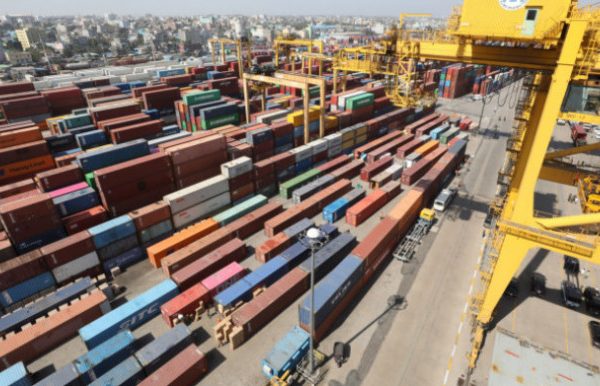Bangladesh’s export earnings rebound from slump
- Update Time : Thursday, November 28, 2024

UNB:
Bangladesh’s export sector is showing signs of steady recovery, overcoming disruptions caused by the political turmoil in July and August that led to the ouster of the Awami League government.
According to data from the National Board of Revenue (NBR), export earnings in October surged by approximately 19 per cent compared to the same period last year.
Goods worth $15.88 billion were exported in the first four months of the current 2024-25 fiscal year, marking an increase of about 11 per cent compared to the same period in the previous fiscal year.
In October alone, Bangladesh exported goods valued at $4.13 billion—$650 million or 18.68 per cent more than the corresponding month last year.
During July, August and September, the country’s export earnings stood at $3.82 billion, $4.07 billion and $3.86 billion respectively.
Bangladesh Bank data indicates that export earnings for the first three months of the current fiscal year amounted to $11.66 billion, a 7.62 per cent increase from last year’s $10.83 billion.
Export earnings during the July-August period were $7.85 billion.
Knitwear exports during the July-September period amounted to $5.35 billion, an 8.25 per cent increase from the $4.94 billion recorded in the same period last year. Woven garment exports rose by 7.33 per cent to $4.16 billion compared to $3.88 billion in the previous year.
Exporters attributed the recent rebound to delayed shipments of orders that had been stuck due to labour unrest, the quota reform movement, and student uprisings during July-September.
Many of these pending orders were shipped last month, several exporters told UNB.
They added that the seasonal demand for winter and Christmas-related products also contributed to the rise in exports, which increased in both value and quantity.
A senior official of the Newage Group confirmed that their factories are operating at full capacity. “We are booked until June 2025, and hopefully other factories are performing similarly,” he said, emphasising that securing work orders depends on reputation, quality, and compliance standards.
An official document suggests that Bangladesh may witness further growth in export volumes, driven by shifts in global trade dynamics.
The World Trade Organization (WTO) forecasts that despite a contraction in global trade in 2023, merchandise trade volumes are expected to grow by 2.6 per cent in 2024 and 3.3 per cent in 2025.
The recovery is expected as inflation subsides, encouraging consumers to purchase more goods.
Emerging Market and Developing Economies (EMDEs) are projected to experience faster export growth than advanced economies.
The Eurozone, which suffered a significant contraction in 2023, is predicted to recover gradually with export growth of approximately 3 per cent from 2025 onwards.
Bangladesh’s export growth, which slowed from 8.79 per cent in 2023 to an estimated 3.93 per cent in 2024, is expected to rebound, reaching 8.83 per cent by 2027.
China’s export growth is forecast to remain moderate, ranging between 1.8 per cent in 2025 and 2.85 per cent in 2026, while India’s exports are projected to recover strongly from a contraction of -2.76 per cent in 2023 to approximately 4 per cent in 2025.
In contrast, the UK is expected to see subdued export growth, with contractions in 2023 and 2024, followed by modest growth rates below 2 per cent until 2027.
Meanwhile, the US is projected to maintain a stable export growth rate of around 3 per cent throughout 2024-27
As exports recover, Bangladesh’s imports are also expected to rebound in the medium term.
According to the IMF, Bangladesh’s import volume growth is projected to recover sharply from a contraction in 2023 to moderate growth of 4.1 per cent in 2024 and robust growth of approximately 18 per cent in 2025.
However, country-specific dynamics reveal varied trajectories. For instance, China’s import growth is expected to decline to 3.4 per cent in 2024 and 0.9 per cent in 2025.
Meanwhile, India’s import growth is forecast to accelerate from 4.8 per cent in 2024 to 6.6 per cent in 2025 and beyond.Import growth in advanced economies such as the UK and the US is expected to remain low, with the UK even projected to experience negative growth in 2025.
















